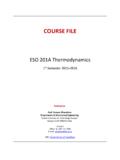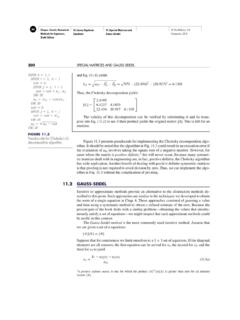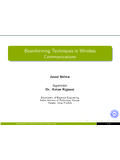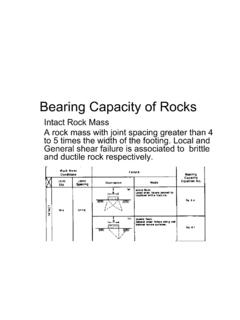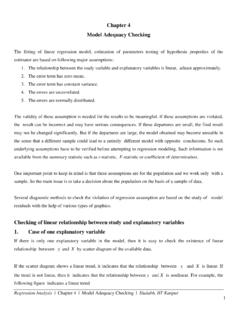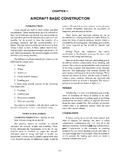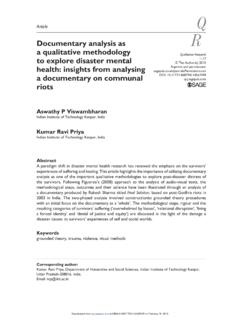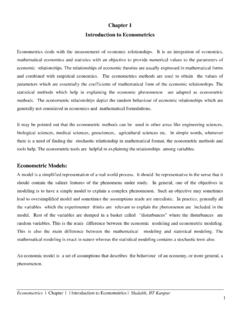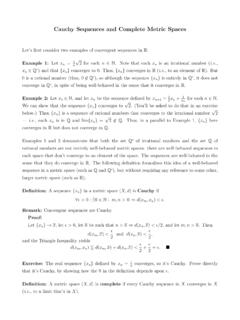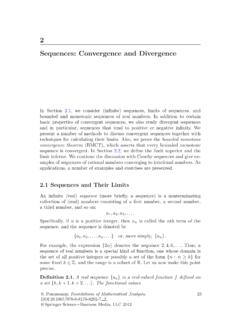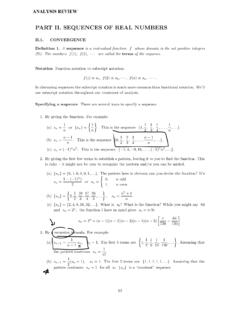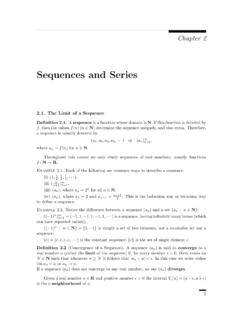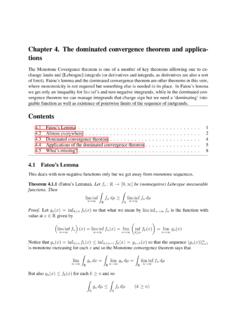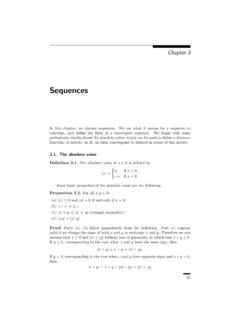Transcription of Lecture 2 : Convergence of a Sequence, Monotone sequences
1 1 Lecture 2 : Convergence of a sequence , Monotone sequencesIn less formal terms, a sequence is a set with an order in the sense that there is a first element,second element and so on. In other words for each positive integer 1,2,3, .. , we associate anelement in this set. In the sequel, we will consider only sequences of real us give the formal definition of a :A functionf:{1,2,3,..} Ris called a sequence of real numbers. We writef(n) =xn, then the sequence is denoted byx1,x2,.., or simply by (xn). We callxnthenth termof the sequence or the value of the sequence examples of sequences :1. (n) = 1,2,3,..2. (1n) = 1,12,13,..3. (( 1)nn) = 1,12, 13,..4. (1 1n) = 0,1 12,1 13,..5. (1 +110n) = , , ,..6. (( 1)n) = 1,+1, 1,+1,..Before giving the formal definition of Convergence of a sequence , let us take a look at thebehaviour of the sequences in the above elements of the sequences (1n), (1 1/n) and (1 + 1/10n) seem to approach a single pointasnincreases.
2 In these sequences the values are either increasing or decreasing asnincreases,but they eventually approach a single point. Though the elements of the sequence (( 1)n/n)oscillate, they eventually approach the single point 0. The common feature of these sequencesis that the terms of each sequence accumulate at only one point. On the other hand, values ofthe sequence (n) become larger and larger and do not accumulate anywhere. The elements of thesequence (( 1)n) oscillate between two different points 1 and 1; , the elements of the sequencecome close to 1 and 1 frequently of a SequenceLet us distinguish sequences whose elements approach a single point asnincreases (in thiscase we say that they converge) from those sequences whose elements do not. Geometrically, itis clear that if the elements of the sequence (xn) come eventually insideevery -neighbourhood(x0 ,x0+ ) ofx0then (xn) us now state the formal definition of :We say that a sequence (xn) converges if there existsx0 IRsuch that for every >0, there exists a positive integerN(depending on ) such thatxn (x0 ,x0+ ) (or|xn x0|< ) for alln can be easily verified that if such a numberx0exists then it is unique.
3 In this case, we saythat the sequence (xn) converges tox0and we callx0the limit of the sequence (xn). Ifx0is thelimit of (xn), we write limn xn=x0orxn :1. Let us show that the sequence (1n) in Example 1 has limit equal to 0. For arbitrary >0, the inequality|xn|=1n< is true for alln >1 and hence for alln > N,whereNis any natural number such thatN >1 .Thus for any >0, there is a natural numberNsuch that|xn|< for everyn The sequence in Example 4 converges to 1, because in this case|1 xn|=|1 n 1n|=1n for alln > NwhereNis any natural number greater than1 .Remark:The Convergence of each sequence given in the above examples is verified directly fromthe definition. In general, verifying the Convergence directly from the definition is a difficult will see some methods to find limits of certain sequences and some sufficient conditions for theconvergence of a following three results enable us to evaluate the limits of many TheoremsTheorem :Supposexn xandyn y.
4 +yn x+ xyify6= 0 andyn6= 0 for :Letxn=112+1+122+2+ +1n2+ 1 12+12 13+ +1n 1n+1 1 Theorem :(Sandwich Theorem)Suppose that(xn),(yn)and(zn)are sequences such thatxn yn znfor allnand thatxn x0andzn x0. Thenyn :Let >0 be given. Sincexn x0andzn x0, there existN1andN2such thatxn (x0 ,x0+ ) for alln N1andzn (x0 ,x0+ ) for alln {N1,N2}.Then, sincexn yn zn, we haveyn (x0 ,x0+ ) for alln proves thatyn x0. Examples :1. Since 1n sinnn 1n,by sandwich theoremsinnn Letyn=n2n3+n+1+n2n3+n+2+ +n2n3+2n. +2n yn +n+1and henceyn Letx Rand 0< x <1. We show thatxn 0. Writex=11+afor somea >0. Then byBernoulli s inequality, 0< xn=1(1+a)n 11+na<1na. By sandwich theoremxn Letx Randx >0. We show thatx1n 1. Supposex >1 andx1n= 1 +dnfor somedn> Bernoulli s inequality,x= (1 +dn)n>1 +ndn> ndnwhich implies that 0< dn<xnfor alln N. By sandwich theoremdn 0 and hencex1n 1.
5 If 0< x <1, lety=1xso thaty1n 1and hencex1n We show thatn1n 1. Letn1n= 1 +knfor somekn>0 whenn > (1 +kn)n>1forn > Binomial theorem, ifn >1,n 1 +12n(n 1)k2n. Thereforen 1 12n(n 1)k2nand hencek2n 2n. By sandwich theoremkn 0 and thereforen1n following result, called ratio test for sequences , can be applied to certain type of sequencesfor :Let(xn)be a sequence of real numbers such thatxn>0for all n andlimn xn+1xn= . <1thenlimn xn= 0,2. if >1thenlimn xn= .Proof :1. Since <1, we can find anrsuch that < r <1. As limn xn+1xn= , there existsn0such thatxn+1xn< rfor alln n0. Hence,0< xn+n0< rxn+n0 1< r2xn+n0 2< < that limn rn= 0 as 0< r <1. So by the sandwich theoremxn Since >1, we can findr R, such that 1< r < . Arguing along the same lines as in1., we getn0 N, such thatxn+1> rxnfor alln n0. Similarly,xn+n0> rnxn0. Sincer >1,limn rn= and therefore limn xn=.
6 Examples :1. Letxn=n2nandyn=2nn!. Thenxn 0 as limn xn+1xn= do similarly Letxn=nyn 1for somey (0,1). Since limn xn+1xn=y,xn Letxn=ns(1+p)nfor somes >0 andp > the argument as in the previuos problem andshow thatxn Letb >1 andxn=bnn2. Then limn xn+1xn= , limn xn= .5. In the previous theorem if = 1 then we cannot make any conclusion. For example, considerthe sequences (n),(1n) and (2 +1n).In the previous results we could guess the limit of a sequence by comparing the given sequencewith some other sequences whose limits are known and then we could verify that our guess iscorrect. We now give a simple criterion for the Convergence of a sequence (without having anyknowledge of its limit).4 Before presenting a criterion (a sufficient condition), let us see a necessary condition for theconvergence of a :Every convergent sequence is a bounded sequence , that is the set{xn:n N} :Suppose a sequence (xn) converges tox.
7 Then, for = 1, there existNsuch that|xn x| 1 for alln implies|xn| |x|+ 1 for alln N. If we letM= max{|x1|,|x2|,..,|xN 1|},then|xn| M+|x|+ 1 for alln. Hence (xn) is a bounded sequence . Remark :The condition given in the previous result is necessary but not sufficient. For example,the sequence (( 1)n) is a bounded sequence but it does not naturally asks the following question:Question : Boundedness +(??) now find a condition on a bounded sequence which ensures the Convergence of the SequencesDefinition :We say that a sequence (xn) is increasing ifxn xn+1for allnand strictly increasingifxn< xn+1for alln. Similarly, we define decreasing and strictly decreasing sequences . Sequenceswhich are either increasing or decreasing are called following result is an application of the least upper bound property of the real :Suppose(xn)is a bounded and increasing sequence .
8 Then the least upper bound ofthe set{xn:n N}is the limit of(xn).Proof:Suppose supnxn=M. Then for given >0, there existsn0such thatM xn0. Since(xn) is increasing, we havexn0 xnfor alln n0. This implies thatM xn M M+ for alln isxn M. For decreasing sequences we have the following result and its proof is :Suppose(xn)is a bounded and decreasing sequence . Then the greatest lower boundof the set{xn:n N}is the limit of(xn).Examples: 1. Letx1= 2 andxn= 2 +xn 1forn > use induction to see that0 xn 2 and (xn) is increasing. Therefore, by previous result (xn) converges. Supposexn .Then = 2 + . This implies that = Letx1= 8 andxn+1=12xn+ 2. Note thatxn+1xn<1. Hence the sequence is >0, the sequence is bounded below. Therefore (xn) converges. Supposexn . Then = 2+ 2. Therefore, = 2.
